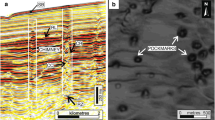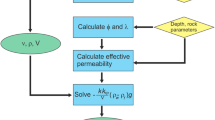Abstract
The objective of this work is to study the migration of hydrocarbons from a source rock into possible reservoirs. In particular, we consider simultaneous migration of gas and oil through a water-filled carrier bed and how this flow might result in characteristics that could be interpreted by nontraditional exploration methods. In the modeling, one-dimensional, immiscible, isothermal flow is assumed, and capillary effects are excluded. The seal is modeled as a layer of very low permeability. Our analysis is based on the method of characteristics and simple wave theory. Waves are changes in saturation(s) that move through a reservoir or carrier bed at a characteristic velocity. The analysis does not require capillary forces to trap hydrocarbons, but relies on nonlinear wave phenomena to explain migration and entrapment. No doubt, capillary forces are important in secondary migration and entrapment. Our treatment can be viewed as being part of a more complete theory on secondary migration, considering hydrodynamic effects here. We demonstrate that capillary forces are not the only mechanism that can cause trapping of hydrocarbons. We focus on the role of gas in the trapping of oil. If the seal is slightly permeable, some oil will flow through it. With gas present, the efficiency of the seal can increase, and oil can be completely trapped by a structure that would otherwise be permeable. For example, gas, being much more mobile than oil, can form a bank at the interface between two layers that have a modest permeability contrast. This gas bank will have a relatively large gas saturation. This will decrease the relative permeability to oil and completely trap subsequently migrated oil. Oil can also be trapped even when no gas bank is formed at the permeable seal. Features of this problem that might affect a seismic signal are (1) the existence of gas above (caused by a stow leakage of gas) and below a modest seal, (2) the gas leakage itself, (3) modest saturations in the oil column, and (4) overpressuring in the gas column.
Similar content being viewed by others
REFERENCES
Baker, L. E., 1988, Three-phase relative permeability correlations: paper SPE 17369, presented at the 1988 SPE/DOE Symposium on Enhanced Oil Recovery, Tulsa, Oklahoma, April 17–20.
Berg, R. R., 1975, Capillary pressures in stratigraphic traps: Am. Assoc. Petroleum Geologists Bull., v. 59,no. 6, p. 939–956.
Delshad, M., and Pope, G. A., 1989, Comparison of the three-phase oil relative permeability models: Trans. Por. Media. v. 4, p. 59–83.
England, W. A., MacKenzie, A. S., Mann, D. M., and Quigley, T. M., 1987, The movement and entrapment of petroleum fluids in the subsurface: Jour. Geol. Soc. London, v. 144, p. 327–347.
Graven, G., 1989, A hydrogeologic model for the formation of the giant oil sands deposit of the western canada sedimentary basin: Am. Jour. Sci., v. 289,no. 8, p. 105–166.
Helfferich, F. G., 1981, Theory of multicomponent, multiphase displacement in porous media: Soc. Pet. Eng. Jour., v. 21, p. 51–62.
Helset, H. M., 1996, Three-phase flow and capillarity in porous media: unpublished dissertation, The University of Bergen, Norway, 131 p.
Hunt, J. M., 1990, Generation and migration of petroleum from abnormally pressured fluid compartments: Am. Assoc. Petroleum Geologists Bull., v. 74,no. 1, p. 1–12.
Johnston, J. R., 1988, Weeks island gravity stable CO2 pilot: paper SPE/DOE 17351, presented at the SPE/DOE Enhanced Oil Recovery Symposium, Tulsa, Oklahoma, April 17–20.
Lake, L. W., 1989, Enhanced oil recovery: Prentice Hall, Englewood Cliffs, NJ, 550 p.
Lax, P. D., 1957, Hyperbolic systems of conservation laws II: Comm. Pure Appl. Math., v. 10, p. 537–566.
Leach, W. G., 1993, New exploration enhancements in S. Louisiana Tertiary sediments: Oil and Gas Jour., v. 91,no. 9, p. 83–87.
McAuliffe, C. D., 1979, Oil and gas migration, chemical and physical constraints: Am. Assoc. Petroleum Geologists Bull., v. 63,no. 5, p. 761–781.
McCain, W. D., Jr., 1991, Reservoir-fluid property correlations—State of the art: SPE Res. Eng., v. 6,no. 2, p. 266–272.
Martinez, R. D., Schroeder, J. D., and King, G. A., 1991, Formation pressure prediction with seismic data from the Gulf of Mexico: SPE Form. Eval., v. 6,no. 1, p. 27–32.
Perry, G. E., 1980, Weeks Island “S” sand reservoir B gravity stable miscible CO2 displacement, Iberia Parish, Louisiana: Fourth Annual Report, June 1979–1980, DOE contract EF-77-C–05–5232, November 1980.
Pope, G. A., 1980, The application of fractional flow theory to enhanced oil recovery: Soc. Pet. Eng. Jour., v. 20,no. 3, p. 191–205.
Price, L. C., 1976, Aqueous solubility of petroleum as applied to its origin and primary migration: Am. Assoc. Petroleum Geologists Bull., v. 60,no. 2, p. 213–244.
Rostron, B. J., 1990, Numerical simulation of oil migration through a lenticular reservoir: unpublished thesis, University of Alberta, Canada, 306 p.
Saraf, D. N., Batycky, J. P., Jackson, C. H., and Fisher, D. B., 1982, An experimental investigation of three-phase flow of water/oil/gas mixtures through water-wet sandstones: paper SPE 10761, presented at the 1982 SPE California Regional Meeting, San Francisco, California, March 24–26.
Siddiqui, F. I., and Lake, L. W., 1997, A comprehensive dynamic theory of hydrocarbon migration and trapping: paper SPE 38682, presented at the 72nd Annual Technical Conference and Exhibition, in San Antonio, Texas, October 5–8.
Siddiqui, F. I., 1996, A dynamic theory of hydrocarbon migration and trapping: unpublished PhD dissertation, The University of Texas, 207 p.
Siddiqui, F. I., and Lake, L. W., 1992, A dynamic theory of hydrocarbon migration: Math. Geology, v. 24,no. 3, p. 305–325.
Smoller, J., 1994, Shock waves and reaction-diffusion equations (2nd Ed.): Springer Verlag, New York, 632 p.
Tissot, B., 1987, Migration of hydrocarbons in sedimentary basins, a geological, geochemical and historical perspective, in B. Doligez, ed., Migration of hydrocarbons in sedimentary basins: Institute Français du Petrole Exploration Research Conference, n. 45, Editions Technip, p. 1.
Tissot, B. P., and Welte, D. H., 1984, Petroleum formation and occurrence (2nd ed.): Springer Verlag, Heidelberg, 699 p.
Ungerer, P., Doligez, B., Chenet, P. Y., Burrus, J., Bessis, F., Lafargue, E., Giroir, G., Heum, O., and Eggen, S., 1987, A 2-D model of basin scale petroleum migration by two-phase fluid flow application to some case studies, in B. Dobigez, Migration of hydrocarbons in sedimentary basins: Institute Français du Petrole Exploration Research Conference, no. 45, Editions Technip, p. 415–456.
Author information
Authors and Affiliations
Rights and permissions
About this article
Cite this article
Helset, H.M., Lake, L.W. Three-Phase Secondary Migration of Hydrocarbon. Mathematical Geology 30, 637–660 (1998). https://doi.org/10.1023/A:1022339201394
Issue Date:
DOI: https://doi.org/10.1023/A:1022339201394




